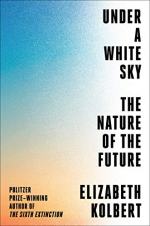|
This section contains 554 words (approx. 2 pages at 400 words per page) |

|
Under a White Sky Summary & Study Guide Description
Under a White Sky Summary & Study Guide includes comprehensive information and analysis to help you understand the book. This study guide contains the following sections:
This detailed literature summary also contains Topics for Discussion on Under a White Sky by Elizabeth Kolbert.
The following version of this book was used to create the guide: Kolbert, Elizabeth. Under a White Sky: The Nature of the Future. Penguin Random House LLC., 2021.
Elizabeth Kolbert's Under a White Sky: The Nature of the Future is written from her first person journalistic point of view. It marries the past and present tenses, and follows a regular structural pattern. The following summary adheres to a similar mode of explanation.
In "Down the River," Kolbert takes a trip down the Chicago Sanitary and Ship Canal. The canal is the result of a historical river diversion. Now the canal is filled with litter and trash. Engineers have also had to construct electric barriers in the water to keep fish out. These images inspire Kolbert's reflections on man's attempts to control the natural world.
From Illinois, Kolbert travels south along the Mississippi River. In Louisiana, she visits the Plaquemines Parish. The Plaquemines is a unique landform, widely known as one of the most rapidly disappearing places in the world. Because of the ways in which humans have attempted to manipulate the course of the river, it has overtaken the land, leading to sunken fields.
Kolbert considers the implications of this problem, while also researching the locally invasive species, the Asian carp. Although carp were originally introduced to American waters to reduce toxicity, they have since taken over. Scientists are currently seeking resolutions to the issue.
In "Into the Wild," Kolbert travels to Devils Hole, a cavern in Death Valley, an arid region in Nevada. The cavern is particularly special because it contains water. This water is home to a rare desert fish known as the pupfish. Because pupfish are dying out, scientists have created a fake Devils Hole where they can artificially breed the fish.
Kolbert travels to Australia to learn more about the coral reefs. Her conversations with biologists including Ruth Gates and Madeleine van Oppen teach her about the possible ways of protecting and preserving such ecosystems.
After meeting with van Oppen, Kolbert travels to Geelong. She visits the Australian Animal Health Laboratory and meets with a biochemist named Mark Tizard. Tizard is in the process of combatting the invasive cane toad species. The carp were initially meant to destroy a population of beetles destroying the country's cash crop, sugar cane. The toads, however, are poisonous to Australia's native species. Scientists like Tizard want to genetically modify the toads to resolve the issue.
In "Up in the Air," Kolbert receives an email from a genetic engineering company called Climeworks. She subscribes to their carbon dioxide conversion program. By paying a sum of money, Kolbert can have the company convert her carbon emissions into rock. Curious about the enterprise, she travels to southern Iceland where Climeworks' operation is based.
Her research in Iceland inspires her interest in other forms of geoengineering. She learns about scientists’ attempts to imitate volcanic aftereffects, cooling the temperature by the same means that volcanic ash cools the climate. Although she is uncertain about these approaches, Kolbert wonders if it is indeed possible to mitigate global warming via such scientific technologies. She decides that all approaches present positive and negative possibilities. No matter which methods are used to combat climate change, she realizes that the nature of the future will look nothing like the nature of the past.
Read more from the Study Guide
|
This section contains 554 words (approx. 2 pages at 400 words per page) |

|



